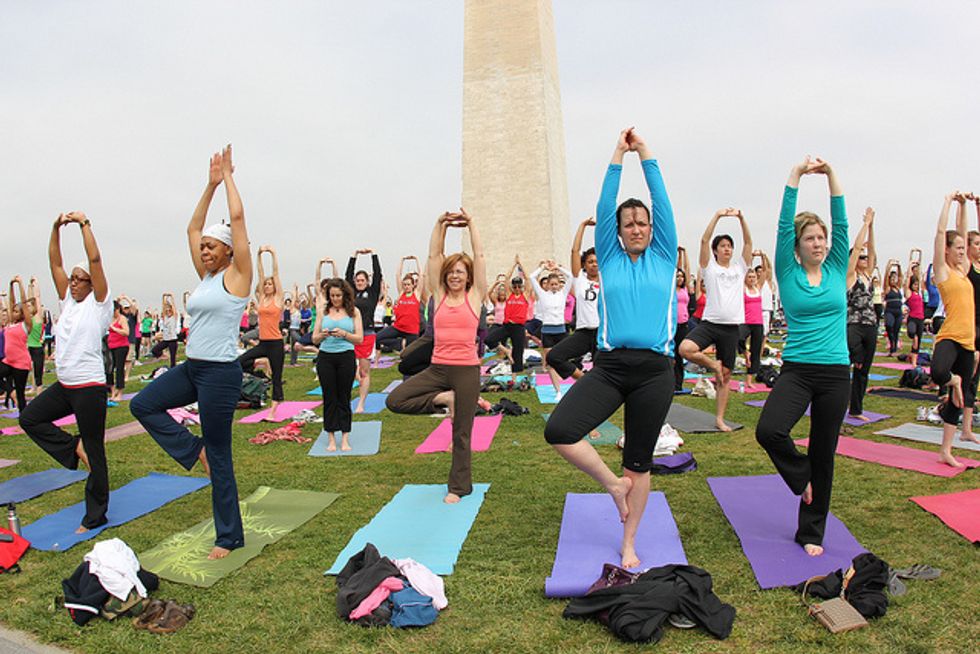Five Yoga Poses For Better Posture
By Emily Abbate, FITBIE.com (TNS)
There are loads of factors that contribute to bad posture. Maybe you work at a job where you’re doing constant repetitive motion without frequent breaks. Perhaps you’re used to carrying a bag around on one shoulder, resulting in a constant lean to the right or left side, or you’re doing the wrong workout. Or perhaps, you’re stuck at a desk job and not getting up and moving enough.
Regardless of the cause, poor posture can result in a slew of issues, including high risk of athletic injury and a restriction of lung capacity. Whatever the case may be, research shows that moving more can be the best medicine for your aching muscles and joints. Our movement of choice? Yoga.
“The regular practice of yoga asana helps create an upright posture by strengthening your core and back muscles, as well as stretching your shoulders and chest,” said Stephanie LaSpina, teacher at Y7 Studio. “Many yoga postures encourage the natural arch and elongation of your spine, directly countering the undesirable hunch in your upper back and shoulders.”
Check out LaSpina’s five yoga poses for better posture:
Wheel pose
Strengthens the back muscles while adding mobility to the spine and shoulders. By strengthening the back body, the spine is brought back into its upright natural alignment. This posture brings the spine into the opposite position of the hunched over spine, fully stretching the shoulders and chest while building strength in the back muscles.
Do it: Laying on your back, step your feet to the ground and make sure you can touch the back of your heels with your finger tips. Ensure your feet are no more than hips width apart. Place the palms of your hands down on the ground framing your ears, fingers point toward your heels. Press down into your feet and hands to rise up into your full wheel backbend.
Plank pose
Often poor posture originates from a weak core. By strengthening the core we are better able to support the lengthening of our spine and open our shoulders. Plank pose strengthens the core, glutes and shoulders.
Do it: From all fours, step your feet back so that your legs are long and straight. Your hands are placed directly under your shoulders as you press back strongly into the balls of your feet.
Cowface pose arms
Opens the chest and shoulders with an intense stretch. Relieves tightness and lengthens muscles after a long day hunched over a desk.
Do it: Sit in a comfortable seat, reach your right arm high above head. Bend your right elbow and place the palm of your hand in between your shoulder blades. Reach your left arm out to the left, bend your elbow and bring the back of your palm in between your shoulder blades. If your fingers meet, clasp your fingers together. If they do not meet, hold onto a strap with both your right and left hand to modify. Gently deepen the stretch by inching your fingers closer and closer to one another until they come to touch.
Upward facing dog
Strengthens the back muscles while stretching the shoulders, abdomen and chest. This posture helps to elongate the spine while building muscle in the back to help support good posture.
Do it: From plank pose, roll over your toes so that the tops of your feet and toes are pressing into the ground. Align hands directly under the shoulders. Press hands and tops of feet into the ground to lift legs and hips off of the ground. Lift the crown of the head up toward the sky as you relax your shoulders down your back and draw the shoulder blades toward on another.
Cat/cow
The combination of these two postures both helps to strengthen the abdomen and back while also finding mobility in the shoulders and spine.
Do it: On all fours, ensure your hands are directly under your shoulders and knees are directly under your hips. As you inhale, arch your spine, drop your belly and gaze up. As you exhale, round your spine, contract your abdomen as you gaze at your navel.
(This story originally appeared on Rodale Wellness.)
(c)2015 Fitbie.com
Distributed by Tribune Content Agency, LLC.
Photo: daveynin via Flickr


